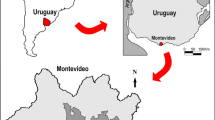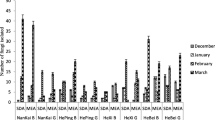Abstract
A quantitative and qualitative survey was carried out for airborne fungus spores coming into contact with horizontally and vertically gravitation sampling oriented surfaces in the atmosphere of Giza city. Czapek Dox agar, malt extract agar, potato dextrose agar and Sabouraud dextrose agar Petri dishes were exposed monthly to the five oriented surfaces of a polystyrene cube, throughout a one-year period. Significant differences (P < 0.01) were observed between the total counts of caught airborne fungi contacting with the horizontal compared to other vertically oriented surfaces. Conversely, there were no significant differences observed between the total catch of airborne fungi using the various sampling media. The results revealed that vertical sampling provides valuable information that may be lost from horizontal sampling alone. A total of 5,053 colonies belonging to 40 fungal organisms were identified. Alternaria (24.26%), Aspergillus (19.2%), Cladosporium (14.5%) and Penicillium (11.43%) were the most predominant fungal genera. Collected fungi were grouped into high, medium, low and rare components depending upon their frequency in the studied atmosphere. Aspergillus niger, Aspergillus parasiticus, Alternaria, Cladosporium and Penicillium were regularly found on all oriented surfaces. However, Arthrobotrys, Biospora, Chaetomium, Pleospora, Trichothecium and Verticillium were rarely found in the air. Positive and/or negative correlations were observed between the total fungal counts and the predominant fungal types with meteorological parameters during sampling days.

Similar content being viewed by others
References
Abdel Azeez, M. A. (1974). Studies on the microorganisms of Cairo atmosphere. M.Sc. thesis, Al Azhar Univ, Cairo, Egypt, 269 pp.
Abdel Hafez, S. I. I. (1984). Survey of airborne fungus spores at Taif, Saudi Arabia. Mycopathologia, 88, 39–44.
Abdel Hameed, A. A. (2005). Vegetation: A source of airborne fungal biocontaminants. Aerobiologia, 21(1), 53–61.
Abdel Wahid, O. A., Moustafa, A. F., & Moustafa, A. M. (1996). Fungal population in the atmosphere of Ismailia city. Aerobiologia, 12(1), 249–255.
Ali, M. I., Salama, A.M., & Ali, J. M. (1976). Possible role of solar radiation on the viability of some air fungi in Egypt. Zentralblatt f ür Bakteriologie, Parasitenkunde, Infektionskrankheiten und Hygine. Zweite naturwissenschaftliche Abt.: Allgemeine, landwirtschaftliche und technische Mikrobiologie, 2, 131, 529–534.
Allitt, U. (2000). Airborne fungal spores and the thunderstorm of 24 June 1994. Aerobiologia, 16, 397–406.
Al Suwaine, A. S., Hasnain, S. M., & Mahkali, A. H. (1999). Viable airborne fungi in Riyadh Saudi Arabia. Aerobiologia, 15(2), 122–130.
Asan, A., Sen, B., & Sarica, S. (2002). Airborne fungi in urban air of Edirne city, Turkey. Biologia, Bratislava, 57(1):59–68.
Asan, A., Iihan, S., Sen, B., Erkara, I. P., Filik, C., Cabuk, A., Demirel, R., Ture, M., Okten, S. S., & Tokur, S. (2004). Airborne fungi and actinomycetes concentrations in the air of Eskisehir city (Turkey). Indoor and Built Environment, 13, 63–74.
Bandyopadhyay, R., Mughogho, L. K., & Satyanarayana, M. V. (1991). Occurrence of airborne spores of fungi causing grain mould over a sorghum crop. Mycological Research, 95(11), 1315–1320.
Barnett, H. L. (1972). Illustrated genera of imperfect fungi. Burgess Publishing Company, Minneapolis, Minn, USA.
Baron, P. A., & Willeke, K. (1993). In K. Willeke & P. A. Baron (Eds.), Aerosol measurement: principles, techniques and applications (pp 8–22). New York: Van Nostrand Reinhold.
Burge, H. A., & Rogers, C. A. (2000). Outdoor allergens. Environ. Environmental Health Perspectives, 108, 653–659.
Cariňanos, P., Galan, C., Alcazar, P., & Dominguez, E. (1999). Diurnal variation of biological and non-biological particles in the atmosphere of Cordoba, Spain. Aerobiologia, 15, 177–182.
Chitaley, S. D., & Bajaj, A. (1974). Air spores of Nagpur at high altitude II. The Botanique Nagpur, 5, 42–52 (Nagpur).
Di Giorgio, C., Krempff, A., Guiraud, H., Binder, P., Tiret, C., & Dumenil, G. (1996). Atmospheric pollution by airborne microorganisms in the city of Marseilles. Atmospheric Environment, 30(10), 155–160.
Dransfield, M. (1966). The fungal air spora at Samaru, Northern-Nigeria. Transactions of the British Mycological Society, 49, 121–132.
Ellis, M. B. (1971). Dematiaceous hyphomycetes. The Western Press Ltd: London and Reading commonwealth Mycological Institute Kew, Surrey, UK, 608 pp.
Etzel, R. A., Montana, E., & Sorenson, W. G., Kullman, G. J., Allan, T. A., & Dearborn, D. G. (1998). Acute pulmonary hemorrhage in infants associated with exposure to Stachybotrys atra and other fungi. Archives of Pediatrics & Adolescent Medicine, 152, 757–762.
Gregory, P. H. (1973). The microbiology of the atmosphere (2nd ed.). New York: John Wiley and Sons, 377 pp.
Gregory, S. (1963). Statistical methods and geographer (1st ed.). Longmans: London, pp. 121–184.
Herrero, B. (1997). Weekly variation of fungal colonies in the atmosphere of Valencia (Spain) throughout the year 1992. The Journal of Allergy and Clinical Immunology, 7, 611–618.
Hjelmroos, M. (1993). Relation between airborne fungal spore presence and weather variables. Cladosporium and Alternaria. Grana, 32, 40–47.
Hudson, H. J. (1969). Aspergilli in the air-spora at Cambridge. Transactions of the British Mycological Society, 52, 153–159.
Johanning, E., Biagini, R., Hull, D., Morey, P., Jarvis, B., & Landsbergis, P. (1996). Health and immunology study following exposure to toxigenic fungi (Stachybotrys chartarum) in water damaged office environment. International Archives of Occupational and Environmental Health, 68, 207–218.
Kowalski, W. J. (2000). Indoor mold growth: Health hazards and remediation. The Pennsylvania State Univ, Dept. of Architectural Engineering. Sept. 2000-HVAC-Heating/Piping/Air Conditioning Engineering.
Lacey, M. E. (1962). The summer air spora at two contrasting adjacent rural sites. Journal of General Microbiology, 29, 485.
Lacey, J. (1981). The aerobiology of conidial fungi. In G. T. Cole, & B. Kendrick (Eds.), Biology of conidial fungi, Vol. 1. NY: Academic press, pp. 373–416.
Levetin, E., & Horner, W. E. (2002). Fungal aerobiology: Exposure and measurement. In M. Breitenbach, R. Crameri, & S. B. Lahrer, (Eds.), Fungal Allergy and Pathogenicity 81. Chem Immunol: Karger Basel, pp. 10–27.
Levetin, E., & Horowitz, L. (1978). A one year survey of the airborne moulds of Tulsa, Oklahoma: Outdoor survey. Annals of Allergy, 41, 21–24.
Leznicka, S., Strzelczyk, A., & Wandrychowska, D. (1988). Removing of fungal stains from stone-works. In IV International Congress on Deterioration and Conservation Stone, Vol. 2, Nicolaus Copernicus University, 12–14 September 1988, Torun, pp. 102–110.
Madelin, T. M. (1994). Fungal aerosols—a review. Journal of Aerosol Science, 25, 1405–1412.
Marchisio, V. F., Airaudi, D., & Barchi, C. (1997). One year monitoring of the airborne fungal community in a suburb of Turin (Italy) and assessment of its functional relations with the environment. Mycological Research, 101, 821–828.
May, E., Lewis, F. J., Pereira, S., Taylor, S., Seaward, M. R. D., & Allsopp, D. (1993). Microbial deterioration of building stone—a review. Biodeter. Abstr, 7, 109–123.
Moubasher, A. H., & Moustafa, A. F. (1974). Airborne fungi at Assuit, Egypt. Egyptian Journal of Botany, 17, 135–149.
Moubasher, A. H., Abdel Fattah, H. M., & Swellim, M. A. (1981). Studies on airborne fungi at Qena. 1. Seasonal fluctuations. Zeitschrift für allgemeine Mikrobiologie, 21, 247–253.
Moustafa, A. F. & Kamel, S. M. (1976). A study of fungal spore population in the atmosphere of Kuwait. Mycopathologia, 59, 29–35.
Pasanen, A. L., Pasanen, P., Jantunen, M. J., & Kalliokoski, P. (1991). Significance of air humidity and air velocity for fungal spore release in the air. Atmospheric Environment, 25A(2), 459–462.
Pelczar, M. J., Chan, E. C. S., & Krieg, N. R. (1993). Microbiology: Concepts and applications. International Ed. P 796. New York: Mc Graw Hill Inc., 966 p.
Raper, K. B., & Fennell, D. L. (1965). The genus Aspergillus. Baltimore, USA: The Williams and Wilkins Comp, 686 pp.
Reponen, T., Willeke, K., Grinshpun, S., & Nevalanen, A. (2001). Biological particle sampling. In P. Baron, & K. Willeke, (Eds.), Aerosol measurement, principles, techniques and applications (2nd ed.). Willey Interscience, A Johan Willey and Sons Inc Publication: New York.
Simeray, J., Mandin, D., & Chaumont, J. P. (1997). An aeromycological study of sawmills: Effects of type of installation and timber on mycoflora and inhalation hazards for workers. International Biodeterioration & Biodegredation, 40, 11–17.
Su, H. J., Wu, P. C., Chen, H. L, Lee, F. C., & Lin, L. L. (2001). Exposure assessment of indoor allergens endotoxin and airborne fungi for homes in Southern Taiwan. Environmental Research, 85, 135–144.
Takahashi, T. (1997). Airborne fungal colony-forming units in outdoor and indoor environments in Yokohama, Japan. Mycopathologia, 139(1), 23–33.
Tee, R. D., Gordon, J., & Taylor, A. J. (1987). Cross-reactivity between antigens fungal extracts studied by RAST inhibition and immunoblot technique. The Journal of Allergy and Clinical Immunology, 79, 627–633.
Urzi, C., De-Leo, F., Paola, S., & Criseo, G. (2001). Airborne fungal spores colonizing marbles exposed in the terrace of Messina Museum, Sicily. Aerobiologia, 17, 11–17.
Youssef, A. Y., & Al Din, A. K. (1988). Airspores of opportunistic fungi in the atmosphere of Cairo, Egypt. Grana, 27, 89–92.
Acknowledgments
We wish to acknowledge the many contributions of Dr. Christopher F. Green, University of Cincinnati, Shawn G. Gibbs, University of Texas and Dr. Khalf M., National Research Center.
Author information
Authors and Affiliations
Corresponding author
Rights and permissions
About this article
Cite this article
Abdel Hameed, A.A., Khoder, M.I. & Emad, A.A. Fertile fungal spores collected on different faced surfaces in the atmosphere of Giza, Egypt. Aerobiologia 23, 47–57 (2007). https://doi.org/10.1007/s10453-007-9048-0
Received:
Accepted:
Published:
Issue Date:
DOI: https://doi.org/10.1007/s10453-007-9048-0




